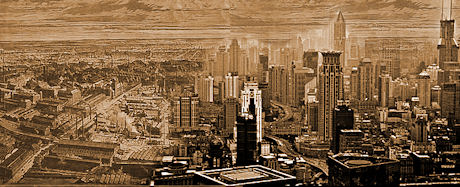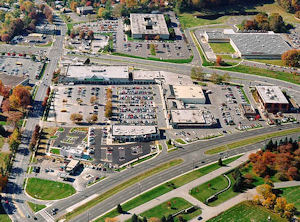Posted December 5, 2007
Many geographers since the 1960s have studied impacts of “spatiality” in working class solidarity. Simply put, every society in a certain historical period has its own particular ways of creating, arranging, and rearranging social and physical spaces, and the processes and the outcomes of spatial arrangements affect workers’ ways of looking at the world, social relations, and their own lives.

Montage of Manchester, England ca. 1850s and modern day Shanghai.
For example, the industrial boom in 19th century Europe was accompanied and accomplished by the development of new transportation and communication systems, such as railroads and telegraph. Railways made it possible for raw materials to be concentrated into huge factories and for manufactured products to be carried out to retailers and customers far away from the factory. In other words, the industrial capitalist society of the 19th century created new spaces like railways and factories.
The newly created spaces changed workers’ living and working patterns. Up until the mid-nineteenth century, manufacturing was conducted in small workshops that were adjacent to the workers’ households. The factory system separated the working place from home and imposed new time and work disciplines onto the workers who now became commuters back and forth between factory and home every day. Living areas between the working-class and the employing class also became segregated.
In the 1840s while he was in Manchester, Friedrich Engels saw positive effects of the segregation of living spaces by class in the formation of working-class consciousness. He found that workers developed their own autonomous activities and organizations, such as reading groups, political clubs, and friendly societies, in their communities where their employers were not around. Historian Wally Seccombe pointed out a negative side of the separation of the working place from home and a new rigid time-discipline on gender roles: it made harder for workers’ wives to participate in the work process and thus contributed to the formation of male-breadwinner norm.
Today, small size sweatshops reappear in the production process, and both factory and small shop production lines are simultaneously exploited at capitalists’ convenience. A new “flexible” time order takes advantage over a large pool of cheap female work force on the one hand, a new rigid “just-in-time” rule in supply squeezes workers during their shift on the other.

Present spatial arrangements as well as the flexible systems in production and labor market complicate labor unionism and working class solidarity. Commercial and entertainment spaces, such as shopping malls, theaters, Disney Land, and baseball stadiums, which are built separately from the working place and home, make workers easily forget the drudgery and inequality in their working places by creating many kinds of sensitivities other than class consciousness. We tend to fight for “consumer rights” more easily than for our “rights as workers.”
As geographer David Harvey has suggested, the working class also needs to create its own spatiality to fight back against the capitalist way of spatiality in order to change and win over the exploitation and alienation that capitalism has created. But how should we begin?
